(* in italicised text are hand-written annotations to the original document)
H.M.S. INDOMITABLE
Bomb Damage
Type of Ship
INDOMITABLE Class aircraft carrier, completed 1941
Principal dimensions.
Length overall 745 feet
Beam on waterline (deep) 95 feet
Draught, deep condition 28’-5” mean
Displacement, deep condition 29,084 tons
III. Circumstances
At 1845B on 12th August 1942 the ship was south west of Sicily escorting a convoy towards Malta and was steaming at 22 knots. Periodical air attacks had been experienced since leaving Gibraltar.
Weather – fine, intensity of light - strong, sea – calm, wind –nil, cloud – nil, visibility 15.
IV. Attack.
a. Seven aircraft, of which at least five were Stukas approached from astern at 15,000 feet. Each aircraft released a 500 kg. S.A.P bomb in a 70 degree dive – the first aircraft at 1,500 feet, the others at lower heights – and then passed over the ship at heights of 50 to 1,000 feet without firing machine guns. The ship was damaged by 2 hits and 3 near-misses. No identifiable fragments were recovered. Detonation of each bomb was judged complete.
b. Hit No. 1. Struck the flight deck at 30 station 6 feet to starboard of the forward edge of the forward lift made a hole 14-inch diameter in the 60-lbs. flight deck, perforated the 10-lbs. upper gallery deck and detonated just above the upper hangar deck after a travel of 16 feet from the point of first impact. Fire broke out, including a petrol fire at the forward end of the hangar, but was under control after 40 minutes. The fire was below and slightly forward of A1 turret and no great heat reached A2. “Clearing charges” in A2 were undamaged, being in a closed locker. In A1, the cordite exploded and split the cylinders. Some shell then fell through the damaged deck into the fire and eventually exploded. A number of large shell fragments were found in the wreckage and landed at Gibraltar. Bomb is judged to be 250 Kgm. S.C. type. *
c. Hit No. 2 struck the flight deck on the middle line at 164 station abaft the after hangar lift, perforated the 14-lbs flight deck and the 10-lbs. upper gallery deck and detonated just above the upper hangar deck after a travel of 16 feet from the point of first impact, in the cabins adjacent to the No. 2 torpedo body room. Fire broke out without igniting the torpedo warheads in their mantlet stowage. Bomb is judged to be 250 Kgm. S.C. type.*
d. Near-miss No. 1 carved a groove in the lower edge of the pom-pom director bulwark at 63 station, port side, and detonated in air 5 feet from the ship’s side at the level of the upper hangar deck after a travel of 16 feet from the point of impact. Bomb is judged to be 250 Kgm S.C. type.*
e. Near-miss No. 2 struck the sea about 25 feet from the ship’s side abreast 125 station, port, and detonated at an estimated depth of 25 feet flooding all wing compartments between 113 and 139 stations, a length of 104 feet. Approximately 760 tons of water entered the ship causing a heel of 8 degrees. * Bomb is judged to be 1,000Kgm or larger S.C. type. A fragment of bomb has been recovered in No2 Naval Store which, on examination, shows that it was probably from a 250 Kg S.C. type although it might have been from a 500 Kg S.C. type bomb. The damage caused would indicate that it fell closer to ship’s side than the 25 feet mentioned by observers.
f. Near-miss No. 3 struck the sea off the port quarter and detonated under water with no serious effect on the ship. About a dozen splinters entered the Captain’s apartments.
V. Structural Damage.
a. Hit No. 1. The 12 and 14-lbs. ship’s side plating was blown out between 21 and 30 stations, lower gallery deck to upper gallery deck. The flight deck was set up 2 feet from 22 station to 34 station, a length of 48 feet.
A hole 20 feet by 12 feet was blown upwards in the upper gallery deck (10-lbs.).
A hole 28 feet by 28 feet was blown downwards in the upper hangar deck (14-lbs.).
Lower Gallery deck broke from its connection at 28 bulkhead starboard for a distance of about 2 feet.
The 14-lbs. bulkhead 21 on upper hangar deck was bulged forward a few inches over the whole width of the ship.
The 14-lbs. bulkhead 28 was destroyed above the upper hangar deck, and bent forward 6 feet at upper hangar deck level between the lift well and the ship’s side.
The 14-lbs. longitudinal bulkhead bounding the starboard side of the lift well was destroyed between 28 and 30 stations, upper hangar deck to upper gallery deck.
Splinters were evenly and closely distributed around the point of burst, travelling effectively a maximum of 30 feet.
The forward lift was canted upwards 5 feet on the starboard side. This was soon afterwards reduced to a 2-ft. 6-in. arch at the middle line in order to allow aircraft to fly off.
b. Hit No 2. A large hole was blown upwards in the 14-lbs. flight deck, length unknown. The plating was soon afterwards burnt off by the ship’s staff in order to remove the obstacle to aircraft landing on, leaving a hole 56 feet long and 40 feet wide between longitudinal bulkheads.
The 10-lbs upper gallery deck was destroyed between 160.5 and 165 stations, a length of 12 feet, over a width of 20 feet.
The 14-lbs. upper hangar deck was destroyed between 161 and 165.5 stations, a length of 18 feet, over a width of 16 feet.
The 14-lbs. lower gallery deck was dished slightly downwards.
158 bulkhead (14-lbs.) between upper gallery deck and upper hangar deck was buckled and distorted over the whole width of the ship.
The after lift sides were set down about 6 inches but the lift was only out of action until ship’s staff faired parts of the platform.
Splinters were evenly distributed about the point of burst, travelling effectively a maximum of 16 feet forward through 158 bulkhead (14-lbs.).
c. Near-miss No. 1 destroyed 17 and 14-lbs. ship’s side plating between 59 and 63 stations, a length of 16 feet, over a height of 12 feet, between lower gallery deck and upper gallery deck.
The 10-lbs. longitudinal bulkhead of the wardroom was torn from its welded heel connection between 58 and 71 stations, a length of 52 feet.
Splinters reached a maximum of 52 feet within the ship, that is, about 57 feet from the point of burst, perforating the 14-lbs. ship’s side and the 10-lbs. wardroom bulkhead.
d. Near-miss No.2 was opposite the after lower corner of the side armour, which was undisturbed. The ship’s side was blown inwards between 121 and 133 bulkheads, a length of 48 feet, with slight dishing between some frames before and abaft those limits. The ship’s side (20, 25 and 30-lbs) was blown inwards from the lower deck to the bottom of the shaft passage, a girth of 30-ft. The hole caused was 40 feet long and 20 feet deep. The after end of the bilge keel was torn from its connections.
e. Near-miss No. 3 unshipped the two woodlocks of the rudder. Splinters were few and travelled a maximum of 20 feet inside the ship.
VI. Damage to Lifts.
Forward Lift.
The platform located at flight deck level but still suspended on the sprocket chains was badly buckled longitudinally, having apparently been forced upwards by blast.
The operating gear, including electrical equipment, on the starboard side was badly damaged and required almost complete renewal.
The differential gear was also damaged.
Transmission gearing on the port side was left in fairly good order except for minor defects but required to be closely overhauled.
The suspension chains on the port side appeared in good condition but may have been strained as the platform was jerked bodily upwards and subsequently dropped. Thus the chains have borne a suddenly applied overload of considerable magnitude.
After Lift.
The after lift, although slightly distorted, was soon restored to operation at half speed by means of the starboard motor.
The platform was slightly distorted having developed an athwartships sag of a few inches mid length.
The operating gear was damaged at the port after corner of the lift where the length of shafting connecting the port side transmission to the differential box was slightly bent and the mitre gearing distorted. This length of shafting was removed to facilitate operation of the platform.
Comment by D.N.C. Department.
a. In the design of these lifts provision had been made for operation under conditions which might produce a considerable degree of misalignment of the transmission gear. This feature, although involving considerable cost, proved to be of great advantage in the case of the after lift as it rendered possible its continued use after damage was sustained.
b. Regarding the position in which the platforms should be during a bombing attack, experience both in ILLUSTRIOUS and INDOMITABLE indicates no technical reason for restricting operation in action.
c. The utility of keeps in electrically operated lifts in the light of their assistance in removing strains from the operating gear under conditions such as those recently experienced does not appear to be well supported observing that in the case of the forward lift the distortion of the platform was such that the keeps would not have registered and in the after lift that the excessive stresses resulting in the distortion of the platform would probably have jammed the keeps and rendered the lift inoperable. Keeps are being abolished for electrically operated lifts.
VII Pumping and Flooding Table.
· Not yet reproduced
VIII Damage Control.
The damage control officer has reported as follows:-
A. Immediate action taken by Damage Control Parties
On 12th August, 1942, at approximately 1845 with ship closed up at “Action Stations”, three explosions were heard in Damage Control Headquarters, and within a few minutes ship listed 10 degrees approximately to port.
2. The following is the approximate sequence of orders and reports received, and action taken:-
From Captain. (i) ‘A’ Turret on fire, flood “A” magazines.
No. 1 Sectional Headquarters were ordered to flood forward group of magazines, Nos. 1, 2, 3 and 4 Pom Pom and Nos. 1 and 2 Fireworks Magazines, Torpedo Warhead and War Small Arms were flooded, and pumped out early on morning of August 13th.
(ii) Correct List.
Previous to explosions, ship had been on an even keel, and five Port Air Spaces contained water to counterbalance natural list to starboard; ten port wing oil fuel tanks contained 75% oil fuel, and starboard tanks 75%. B and C oil tanks were empty.
Nos. 2, 4 and 6 Rapid Flood Positions were ordered to pump out their respective air spaces, and Nos. 1, 3 and 5 to Flood starboard air spaces. This was carried out under the direction of Double Bottom Chief Stoker and ship returned to even keel about 30 minutes after listing, when order was given to stop flooding starboard.
From No. 3 Sectional Headquarters.
1) Petrol system drained
2) Large fire aft, Lower Hangar Decks
3) Main Naval Store flooded 3 to 4 feet
Aircraft on fire in Upper Hangar put out by hose and armoured doors closed
Fire in Torpedo Body Room and cabins extinguished by hose.
Fire in Fabric Store in hand
Manhole of hatch to Naval Store was found open and 4 ft. water in store; manhole in hatch under, to No. 2 Naval Store was also wide open (F.A.A. had been down to Oxygen Store 10 – 15 minutes previously). Manhole to No. 2 Naval Store was eventually shut and shored.
All adjacent compartments had been examined and found watertight; no doors or hatches were opened to check this.
Portable pump was rigged and Main Naval Store pumped out.
Later it was found by test plugs that Decontamination Store and Gunner’s Arms Store were flooded, and decks were shored.
One fresh water pump was fractured, and fresh water pump was stopped temporarily to prevent loss of water.
More firemain pressure was asked for; at least 17 hoses were in use on the after fire, excluding those run along the flight deck. Firemain at 121 and 139 was therefore de-isolated and Starboard Engine Room ordered via the Machinery Control Room to boost pressure as much as possible, this gave four in number 75 ton pumps applying water, and this was ample.
H.P Air leaking aft.
Line isolated in wingworkshops.
Report from No.1 Sectional Headquarters
1. Dense smoke in Central Communications Office and Switchboard Flat. This was drawn in through ventilation supply from fire in Boys’ Messdeck. Ventilation Valve shut.
2. “A” pump out of action; firemain de-isolated; more pressure required, fire in Chief Petty Officer’s Mess.
Firemain was further de-isolated at 61 starboard and second pump in Centre Engine Room started, and running pumps in Engine Room and Starboard Boiler Room boosted, this gave 100 lbs/in. pressure at pump. After 30 minutes fire reported under control.
3. Small fire in Boy’s Mess and fire in Torpedo Body Room. Fire in Boy’s Mess soon under control, but Torpedo Body Room caused trouble due to calcium store adjacent catching fire; after much water had been poured on, fire was eventually taken under control by using chemical fire extinguishers and sand.
Additional fire fighters and equipment were sent forward to Torpedo Body Room, Petty Officer’s Mess and “A” turret by Damage Control Headquarters, this depleted No. 3 Damage Control Party, until some Fleet Air Arms ratings arrived.
4. Kit locker flat flooding through ventilation trunk. Found that Hangar Spray Flushing pipe had burst, water entering trunk. Flooding ceased when spray cut off.
5. Forward fresh water pumps out of use, and fresh water line damaged in Petty Officer’s Mess. Fresh water line isolated.
6. C.O.2 machine stopped; one condenser leaking and isolated; slight leak of gas; all valves shut; compartment evacuated.
7. Small fire in Ward Room caused by bombs soon extinguished.
8. H.P. air line cut in Torpedo Body room – shut off in Seamen’s washplace.
Report of Action taken in Hangars.
1. Lower Hangar reported no damage.
2. Fire occurred in Upper Hangar, forward, due to large lubricating oil drop tray, full up, catching alight, and also a petrol hose aft. Both fires extinguished with foam generators.
Spray pumps were started as soon as fires were seen, and attempts made to drop curtains; No. 1 Fire Curtain came down electrically; after Fire Curtain was jammed by blast.
A large fire was raging starboard side, forward of Upper Hangar, rendering access impossible. Hangar became full of smoke and lit by red glare from end to end; it could not be ascertained whether hangar was on fire or not, so it was sprayed from Port forward, starboard aft and starboard midships positions, maximum was 6-in (depth) at 8 degree list to port; water cleared quickly.
A fire was seen to be raging in fabric store and hoses were sent to assist.
Assistance and 4 hoses were sent to fight fire in forward Torpedo Body Room.
B. Action taken by Damage Control Parties
1. Auxiliary Hydraulic line tested and found fractured abreast “A” turret; water had been lost from hydraulic tanks and fresh water was not available. Adaptor was therefore fitted to “shore Reserve Feed Tank filling connection” on Lower Gallery Deck and hose run aft to tank filling funnel. Evaporator then discharged distillate to hydraulic tank and system was in working order except for isolated damaged portion. It was considered (urgently) necessary to reaise starboard wireless masts to enable destroyer to assist in fire fighting.
2. Salt water was being continually discharged through deckhead of Captain’s Quarters and flooding keyboard flat. Leak amongs the debros could not be found so 158 Firemain Bulkhead Valve was sut.
3. Firemain pressure was lost forward through cooling water to “A” turret pump fracturing, so lead from Main Deck shut off.
4. All (4) portable pumps were rigged and used to pump out messdecks, kit locker spaces and flats.
5. Compartments adjacent to those flooded were tested, plugged and shored as necessary. Certain compartments which appeared to be flooded owing to indicator teat plug showing an air pressure were found later to contain only a few inches of water.
6. It was considered possible that a lead of firemain was fractured in a flooded compartment (No.2 Naval Store). Pressure to this load was therefore shut off.
7. “Z” petrol tanks were tested to check for leaks.
C. Ship’s Conclusions and Recommandations concerning Damage Control.
1) All Damage Control Organisation worked calmly and efficiently, telephones remained in use and information was received and passed and orders carried out with very little delay.
2) Firemain pressure, numbers of hoses and branch pipes were ample to cope with the fires, but more spray nozzles are required to cope with smoke.
3) Indicator test plugs were used successfully. The leather joints of these fittings did not stand up to salt water and it is submitted that in future washers be made of red fibre, and the securing nut of plug be made tight with a set screw.
4) The portable “Snorer” pumps were a great value and gave no trouble whatsoever. Discharge hoses had to be led up to the weather decks as drains of bathrooms could not cope with discharge; this entailed a number of water tight doors and hatches remaining open; it is submitted therefore, that discharge hose connections and watertight sluice valves be fitted on ships’ side just above main deck level.
5) Manhole doors of hatches are difficult to make watertight properly unless closed by an experienced officer or rating. Some simpler means of clipping is considered necessary as it is not obvious which way the clip should be moved when the door is being shut from above..
6) Magazine door keyhole fittings had been left in the “open” position; it is submitted that these fittings be made larger and more definite in action and that they e made more accessible by fitting them further away from the door frame.
7) A number of magazine doors were found to be non-watertight under pressure, pressure tending to keep door shut. In one case compartment was pumped out, and all clips hammered up evenly, but as soon as compartment flooded up again clips became slack and water leaked through. It is considered that there is insufficient “bite” between clip and wedge, and it is submitted that clips be made on inclined plane to contact surface of wedge.
8) Watertight hatch to Nos 1 and 2 small arms magazines had been secured with one clip only; this together with items 6) and 7) is considered the cause of the lower magazines of the after group becoming partially flooded.
Comment by D.N.C. Department
1 The firefighting organisation worked well.
2 C.2. The allowance of spray nozzles has been increased to 30% of the total number of branch pipes. A.F.C. 3023/42
3 C.3. A better oint is being arranged. A.F.O.2425/42.
4 A.F.O 167/42 ordered the provision of side scuttle blanks fitted with hose connections for overboard discharge from portable pumps.
5 C.5. This matter is frequently raised by ship’s officers. The single wedges are fitted, the positions and directions of movement of the clips should be painted on the manhole covers and stops fitted in order to prevent the openings being closed with the clips on the wrong sides of the wedges.
6 C.6. This will be borne in mind in future designs.
7 C.7. A comprehensive series of experiments has been in hand for some months with the object of strengthening designs of watertight doors and hatches. A number of conclusions from these experiments has already been put into practice, as described in A.F.O.3905/42, and A.F.O. 5051/42.
IX. Ship’s General recommendations.
· Not reproduced
X. Effect on Fighting Efficiency.
Armament
A1 and A2 4.5” B D mountings out of action; “A” T.S. slightly flooded, but never out of action. “B” director out of action.
Aircraft
Forward lift completely wrecked.
After lift temporarily out of action until faired up by ship’s staff. Aircraft accelerator track warped.
Casualties.
Casualties consisted of 6 officers and 40 ratings killed, and 70 ratings wounded.

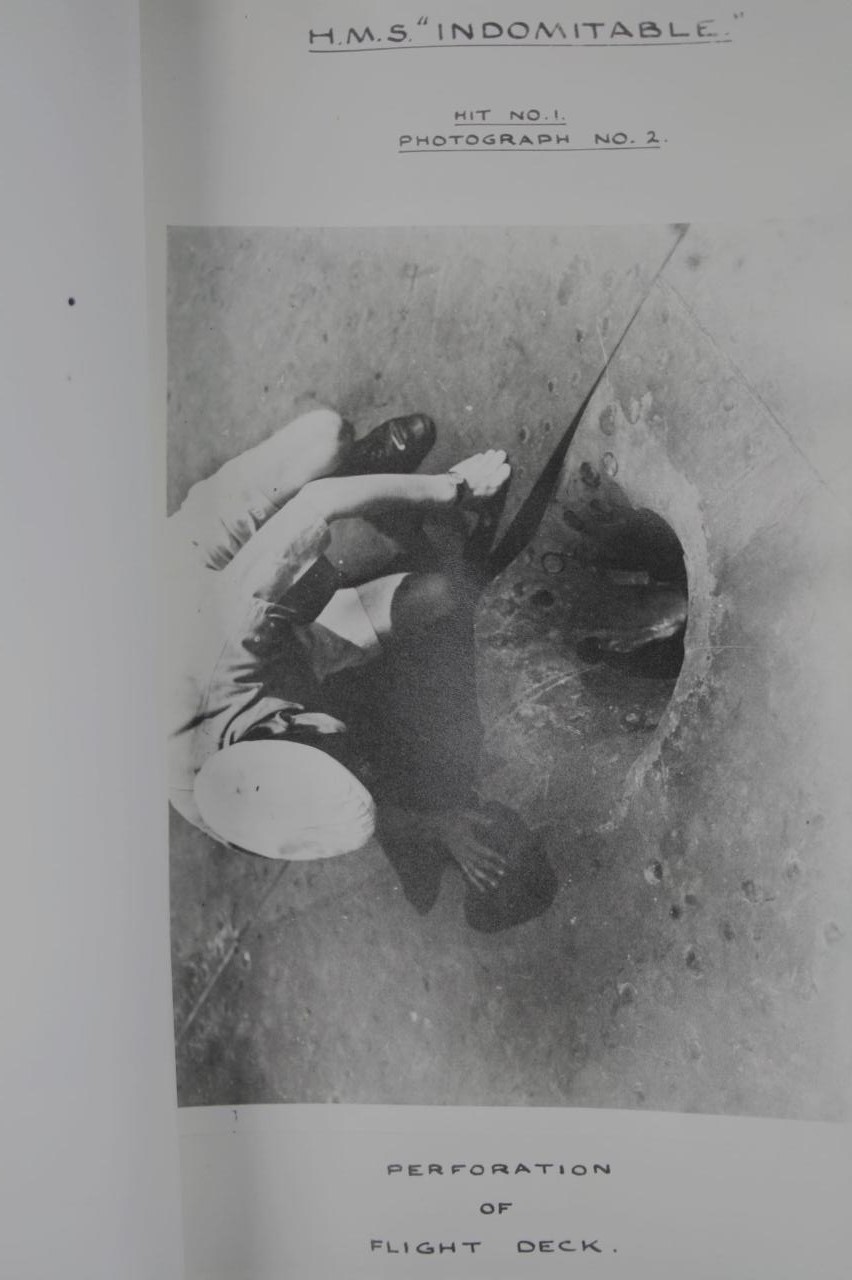
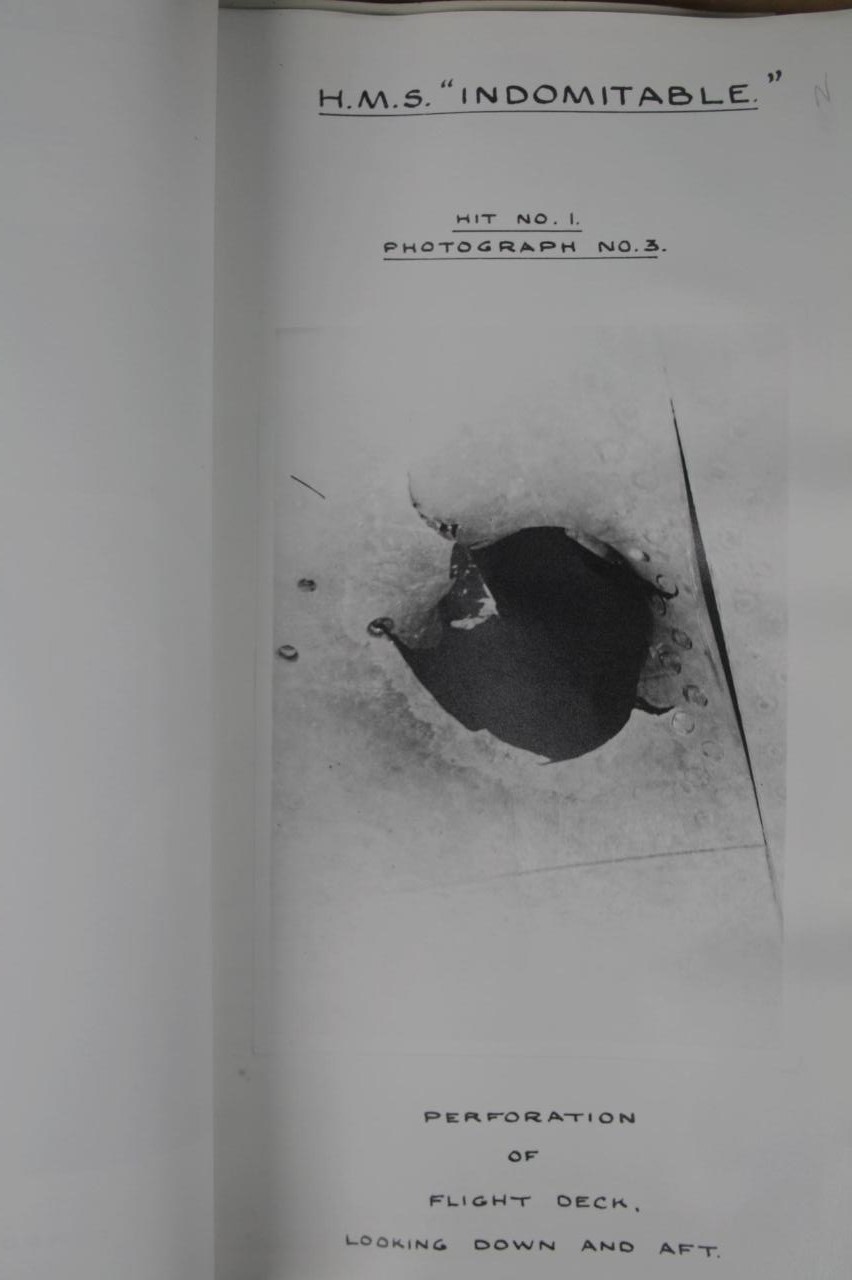
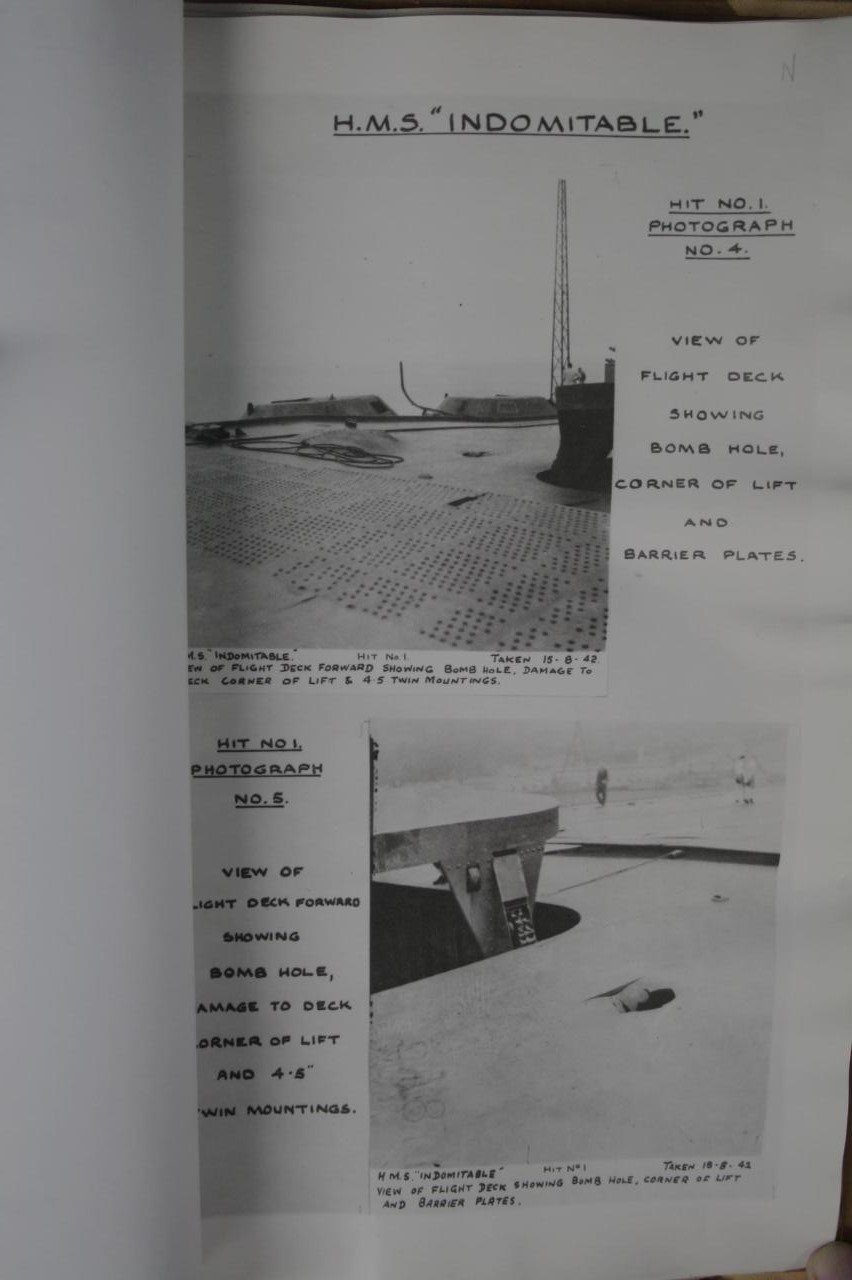
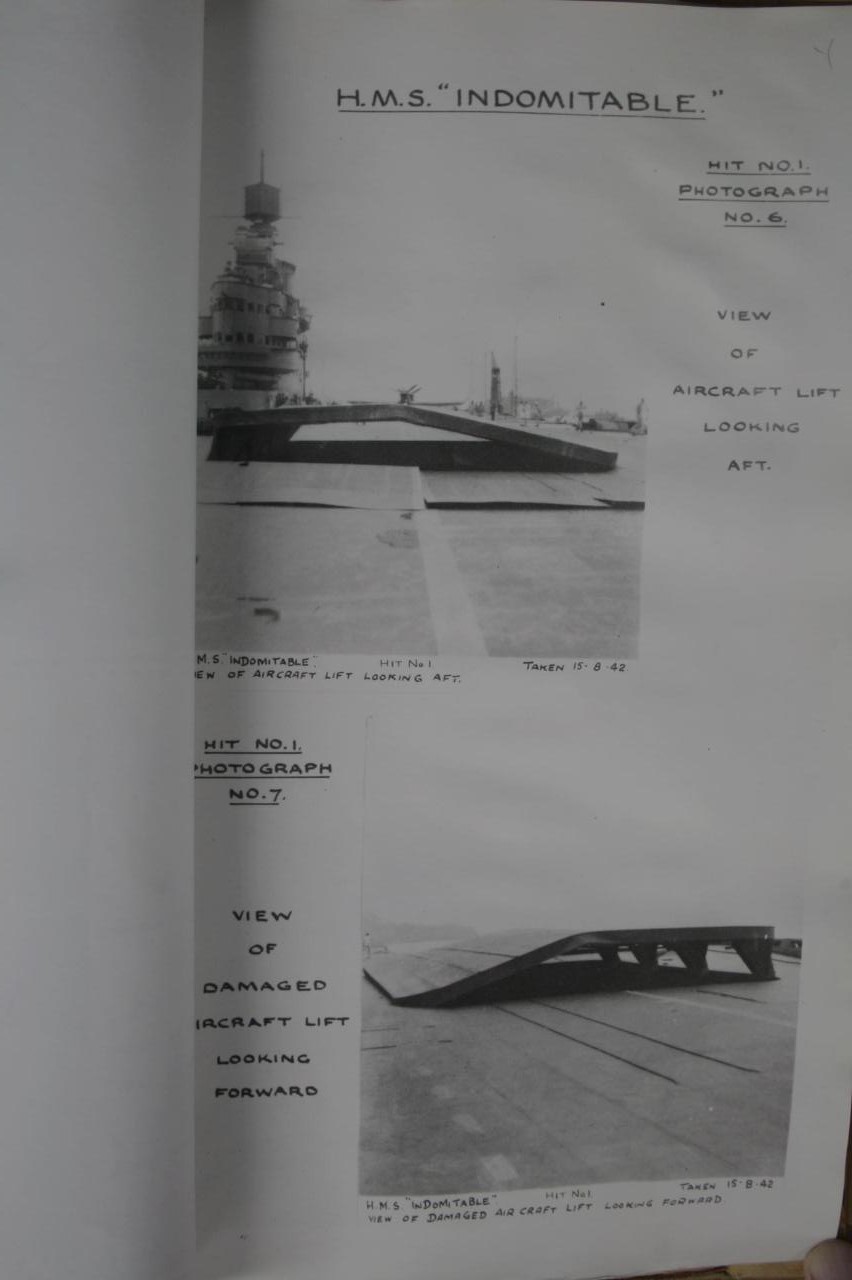


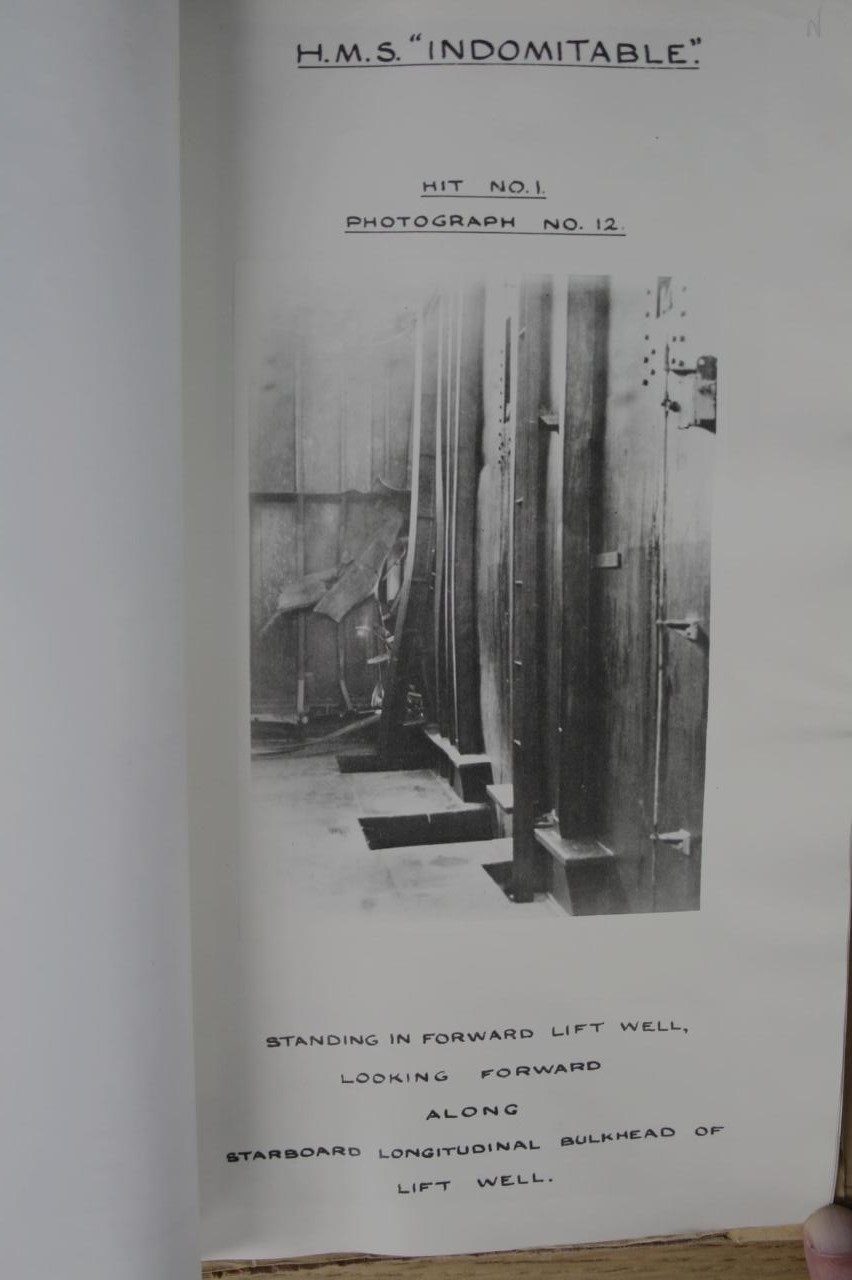
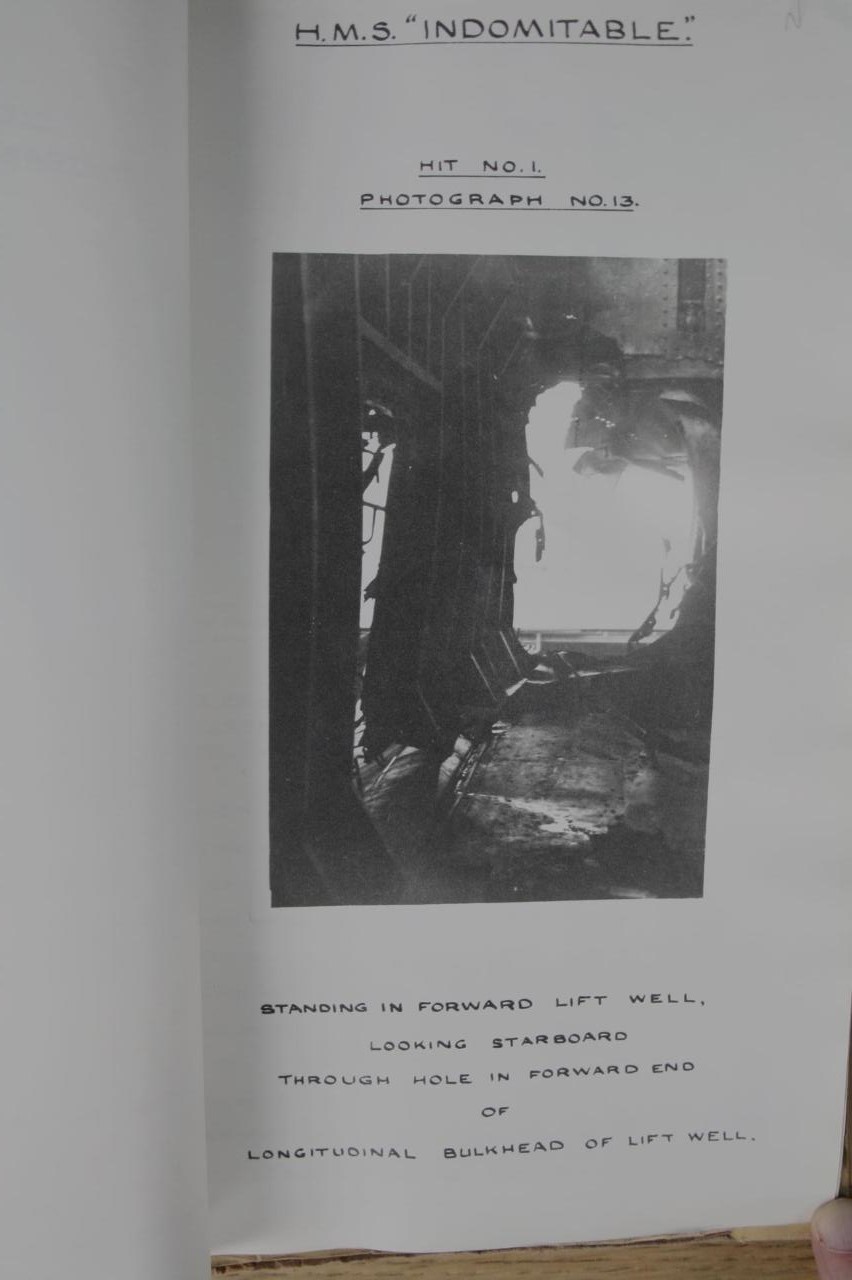
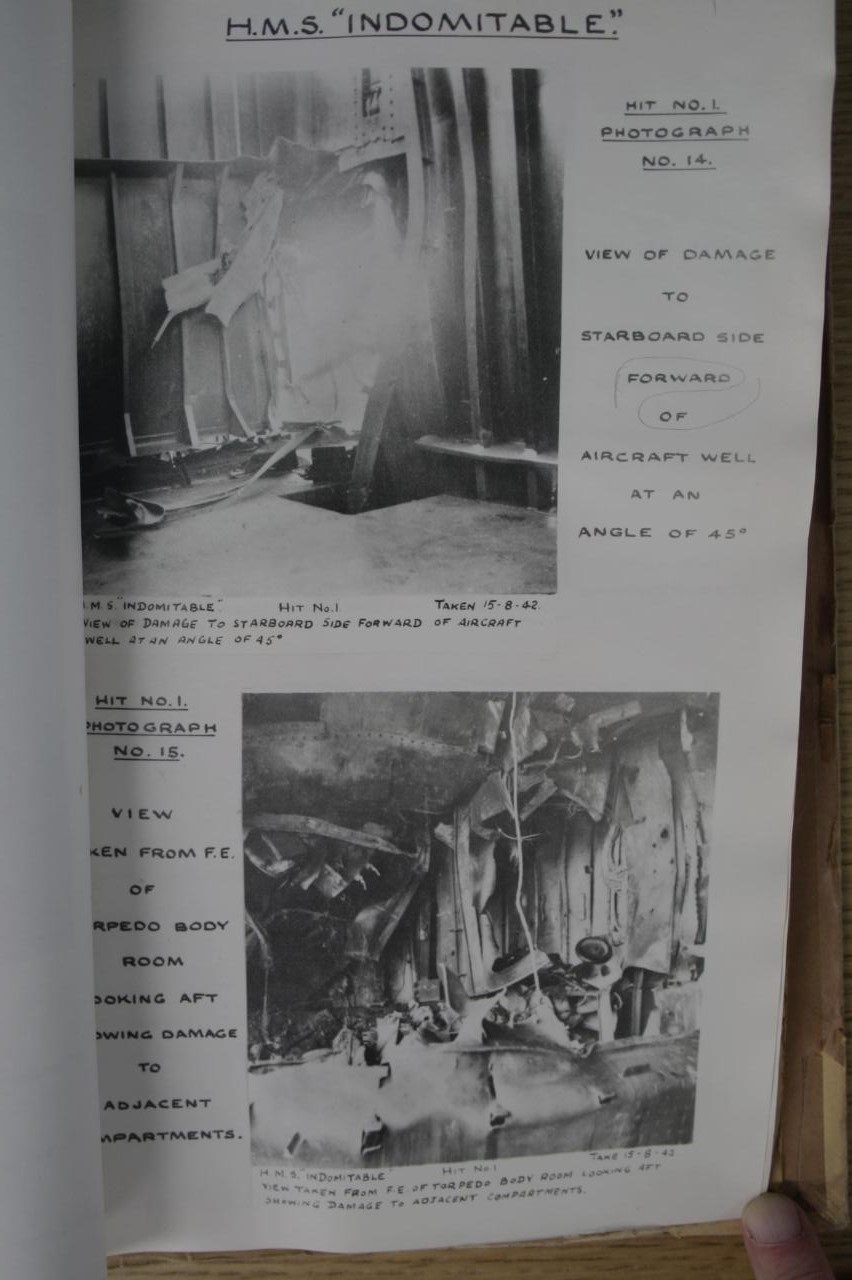
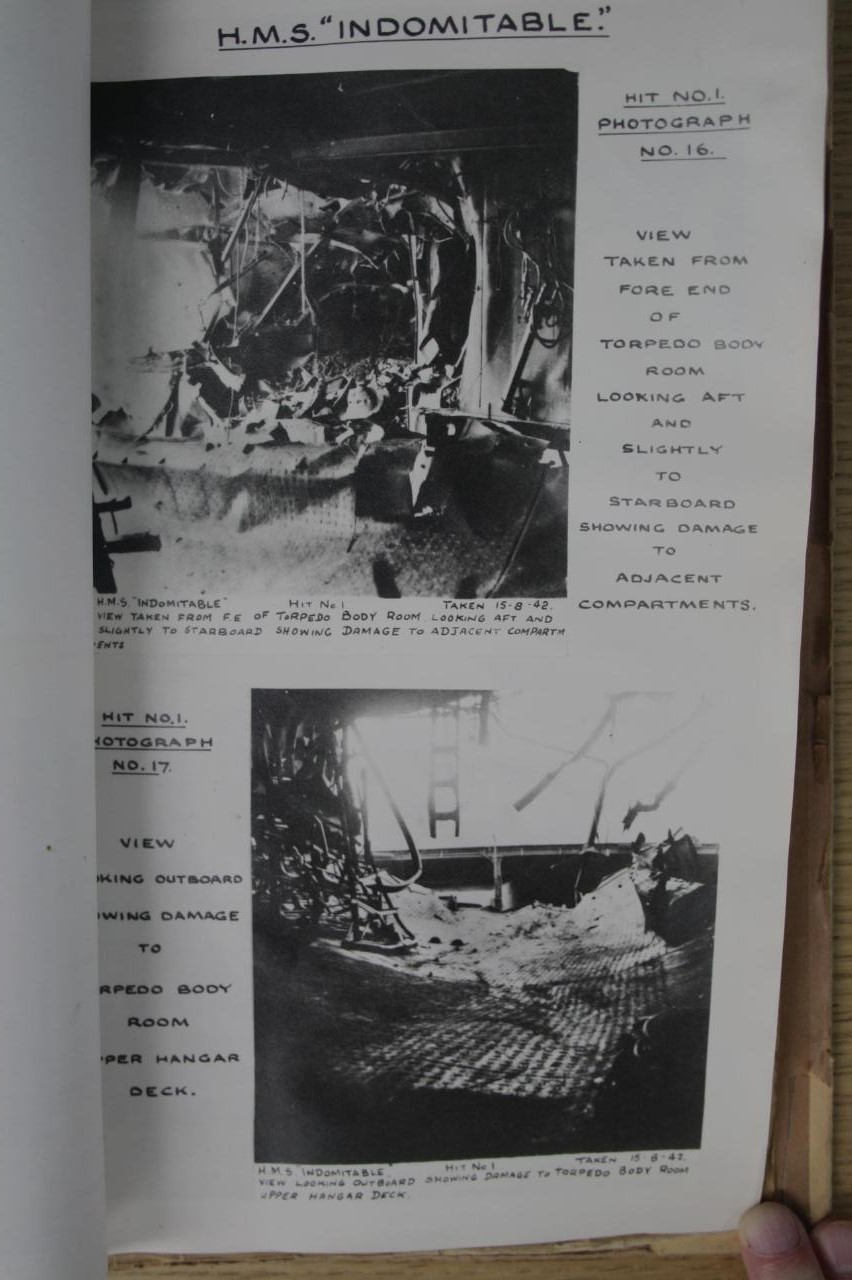
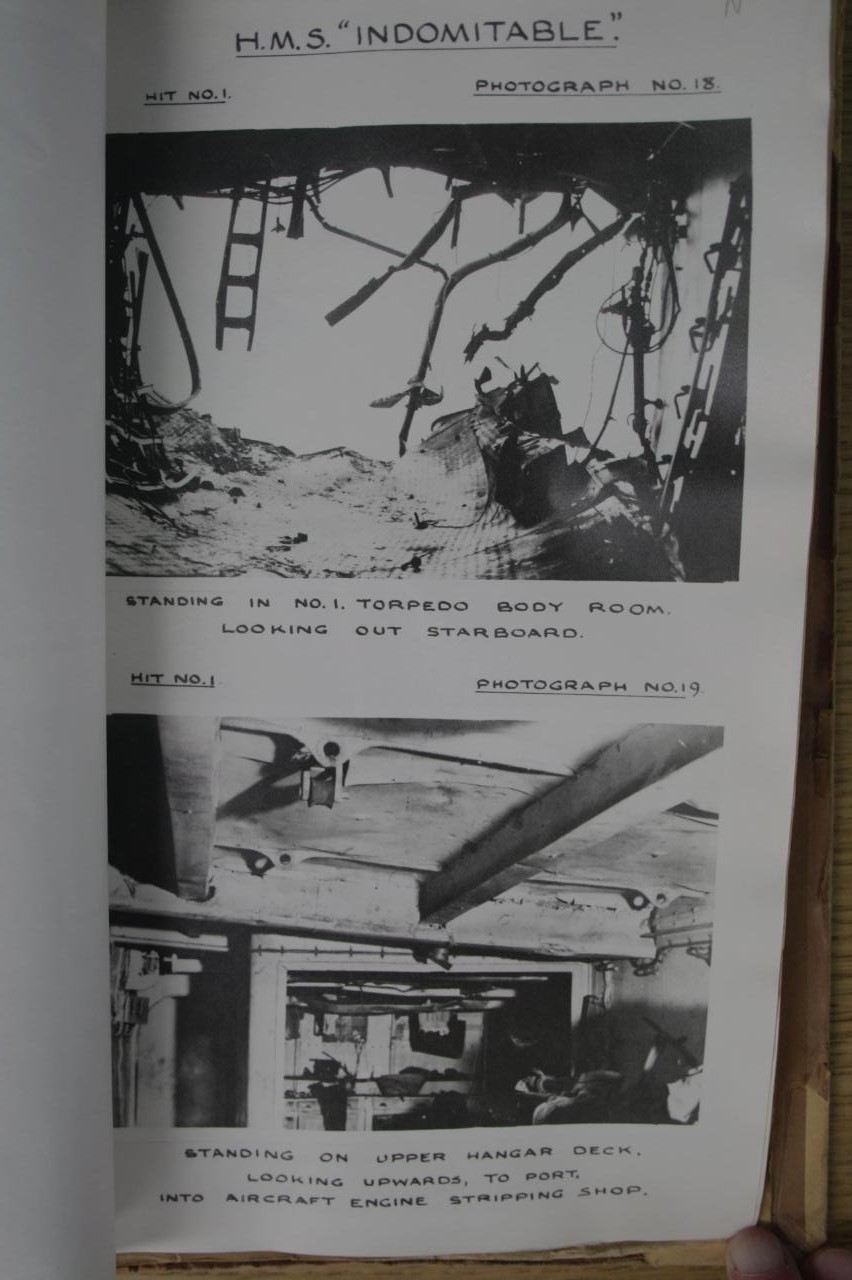
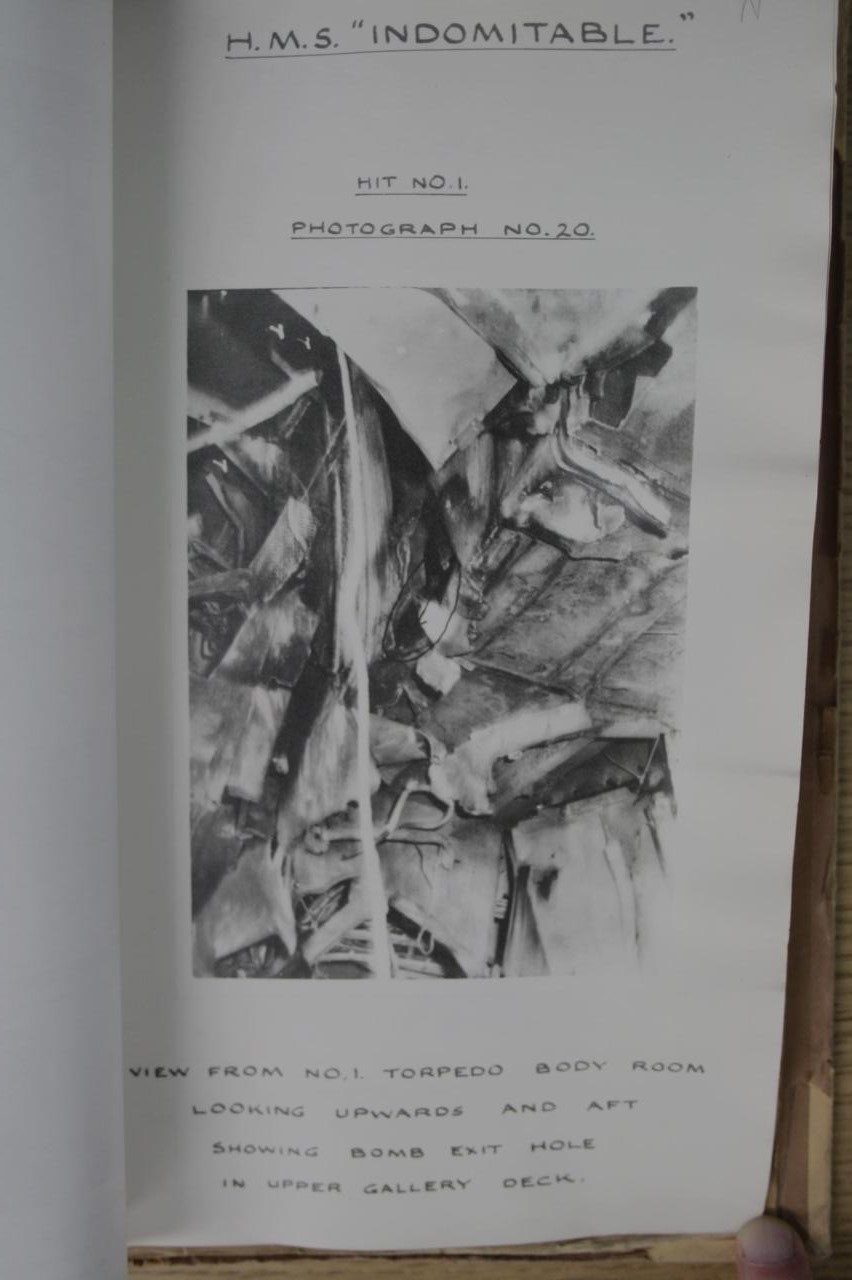
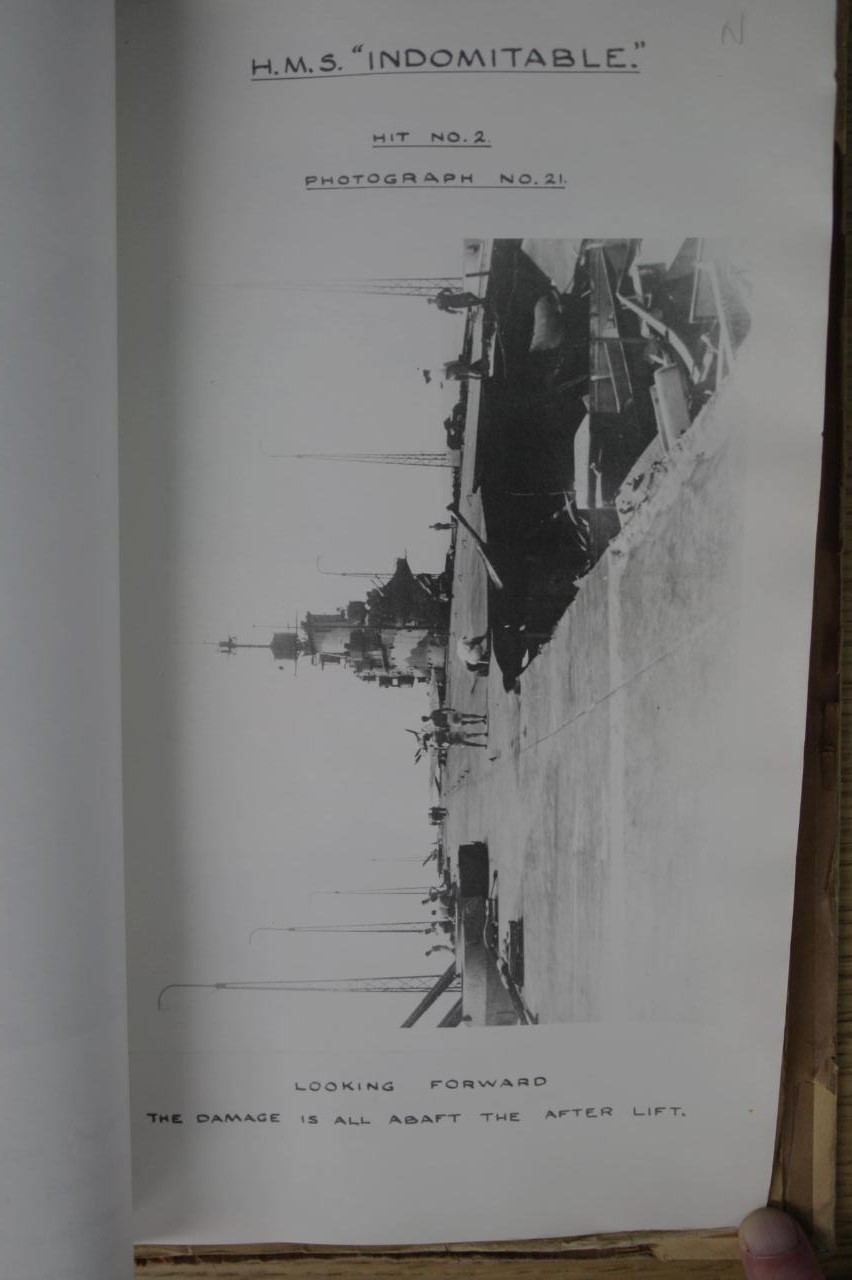
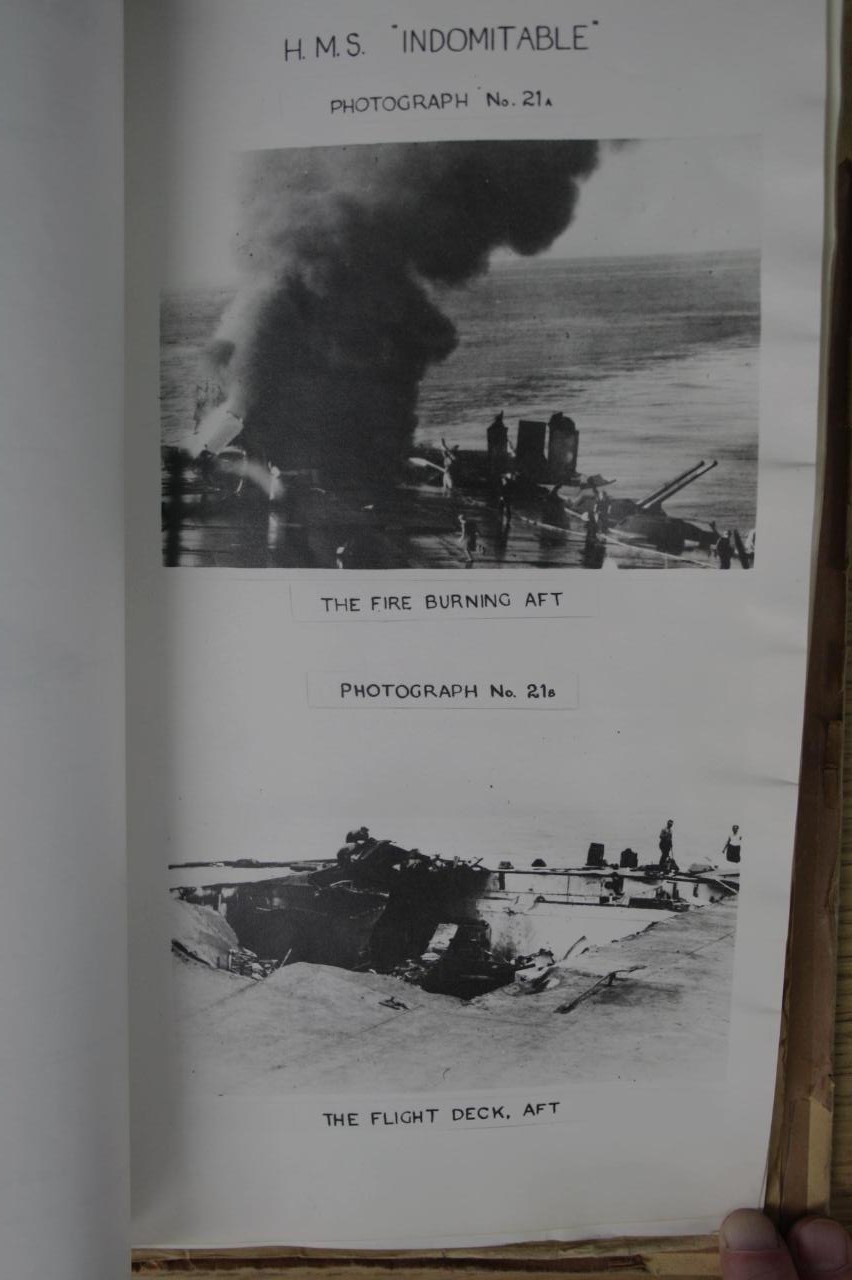
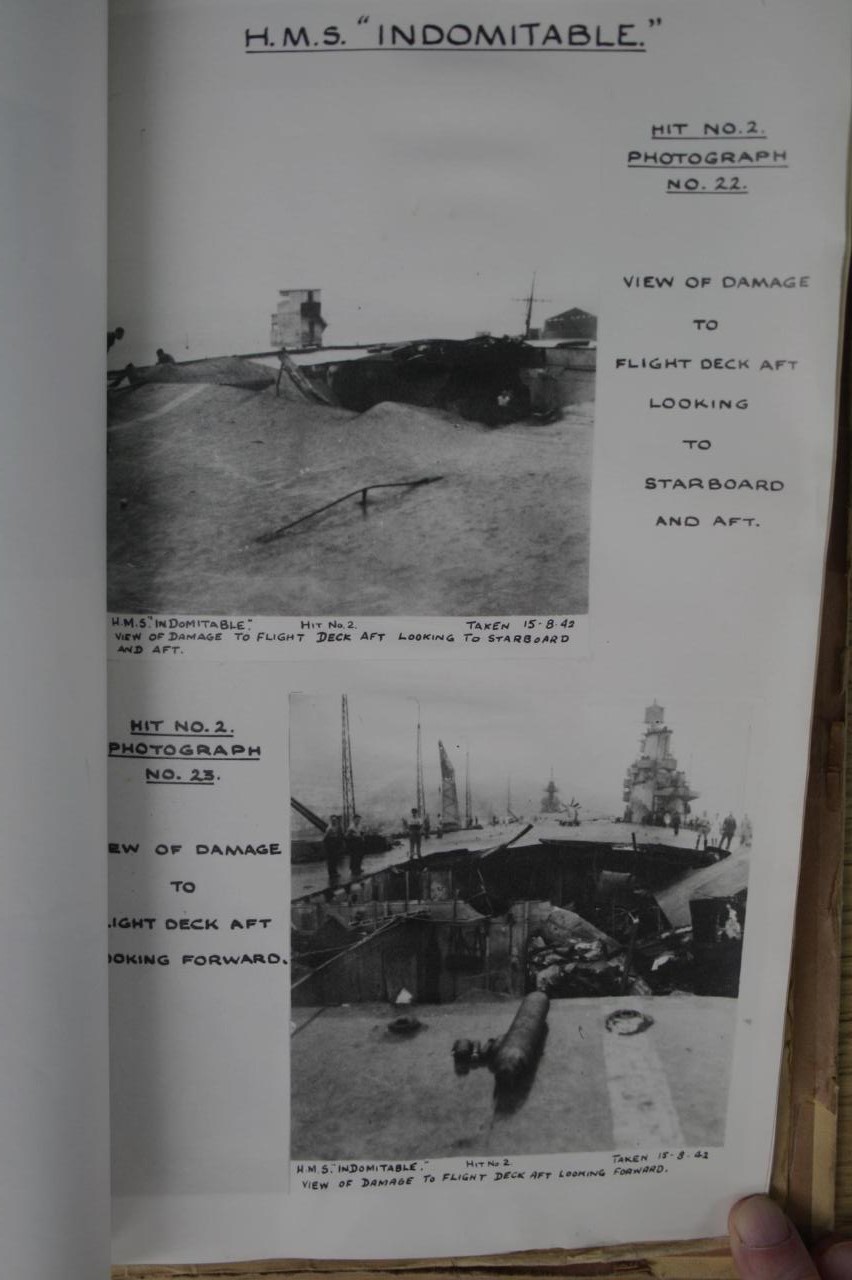
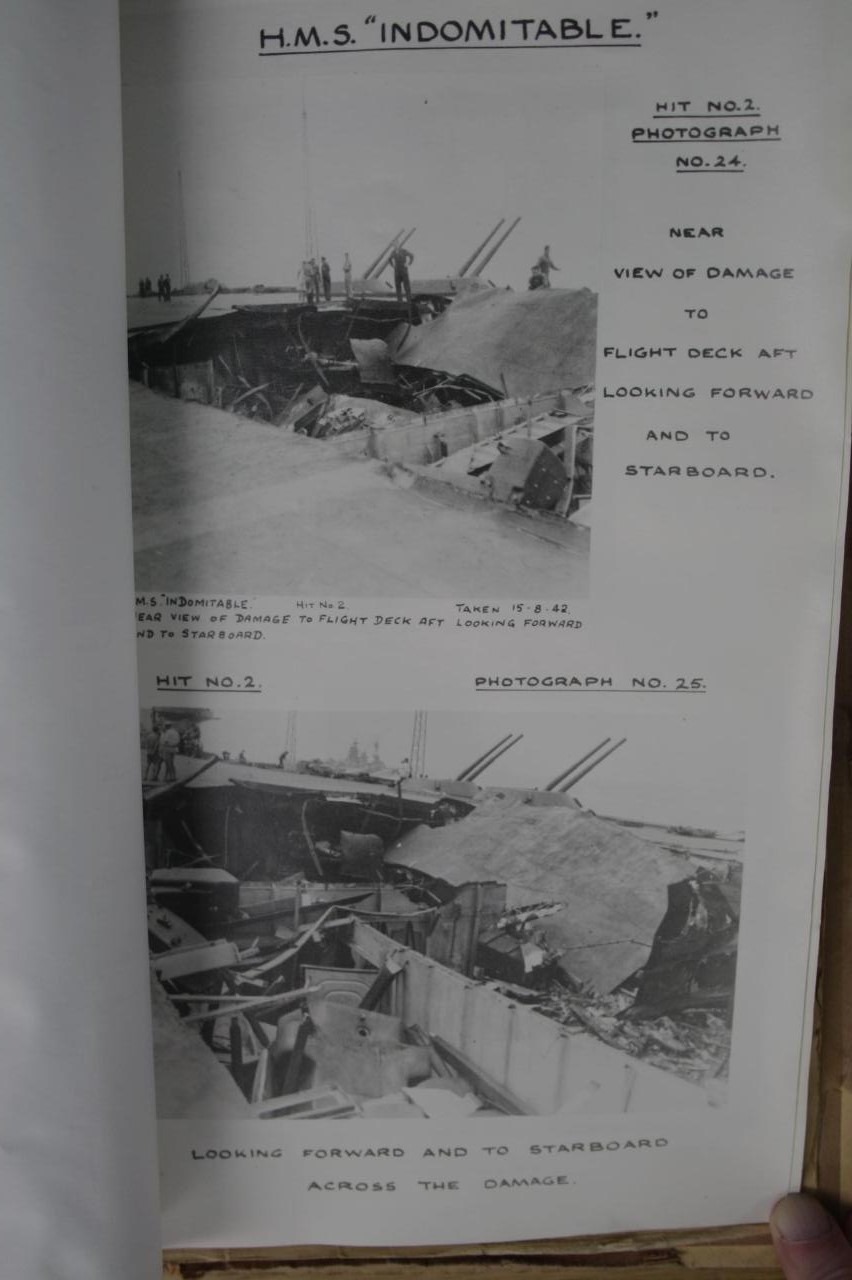
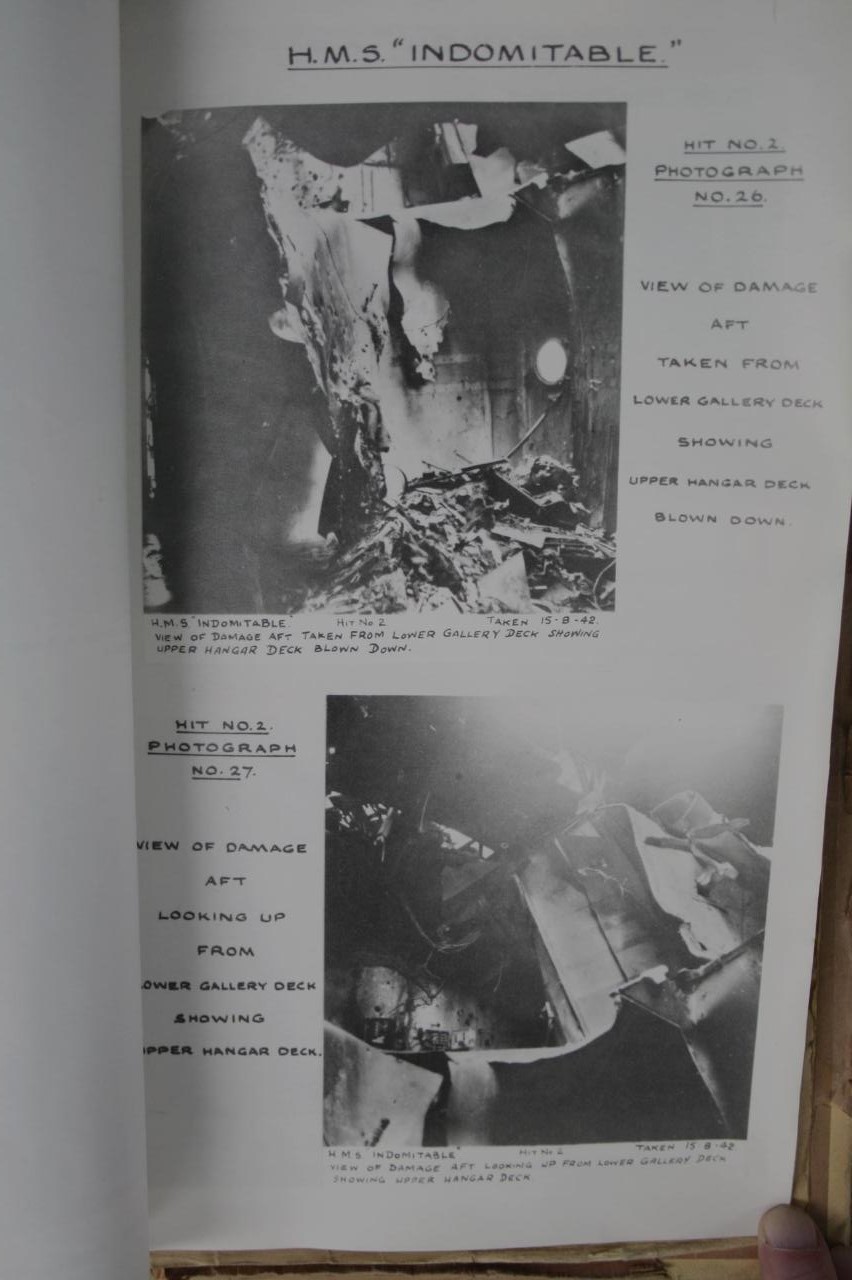
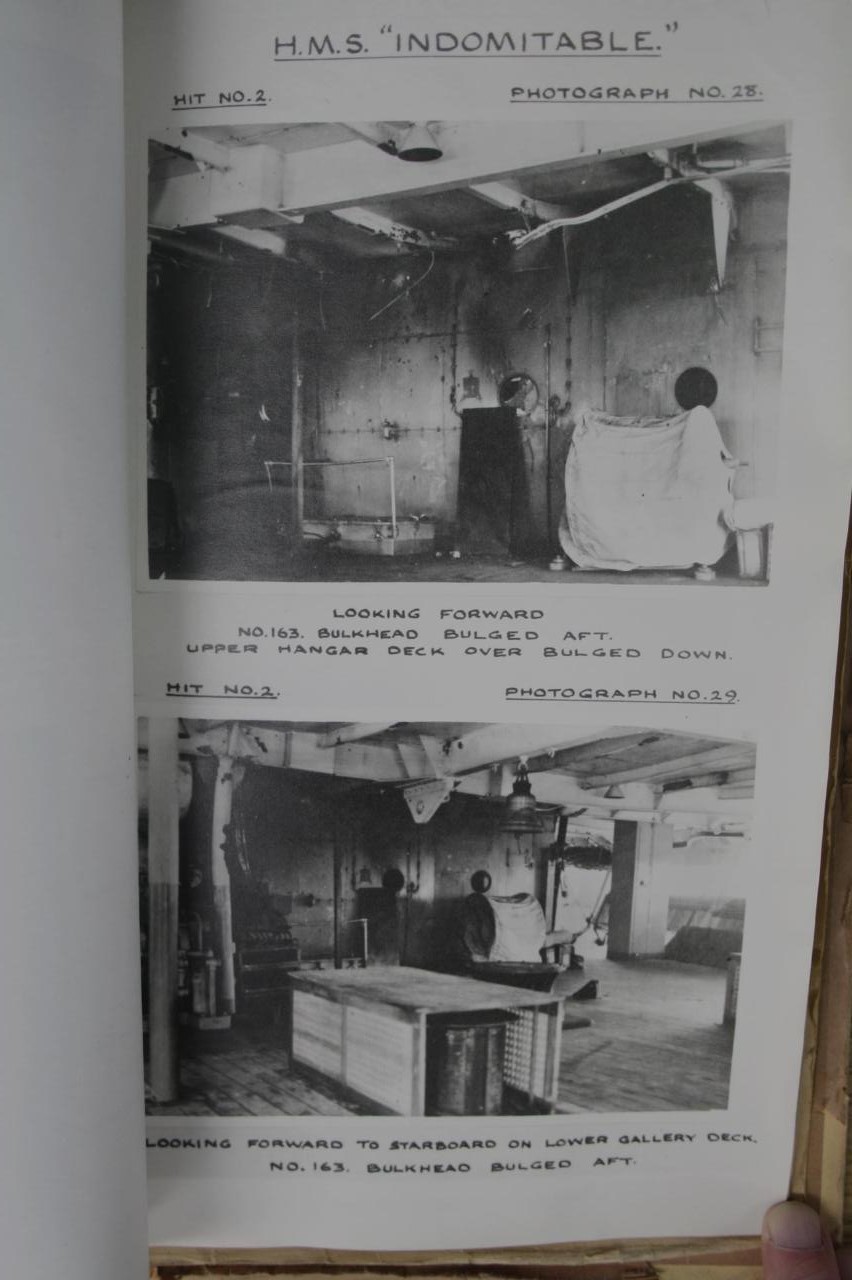


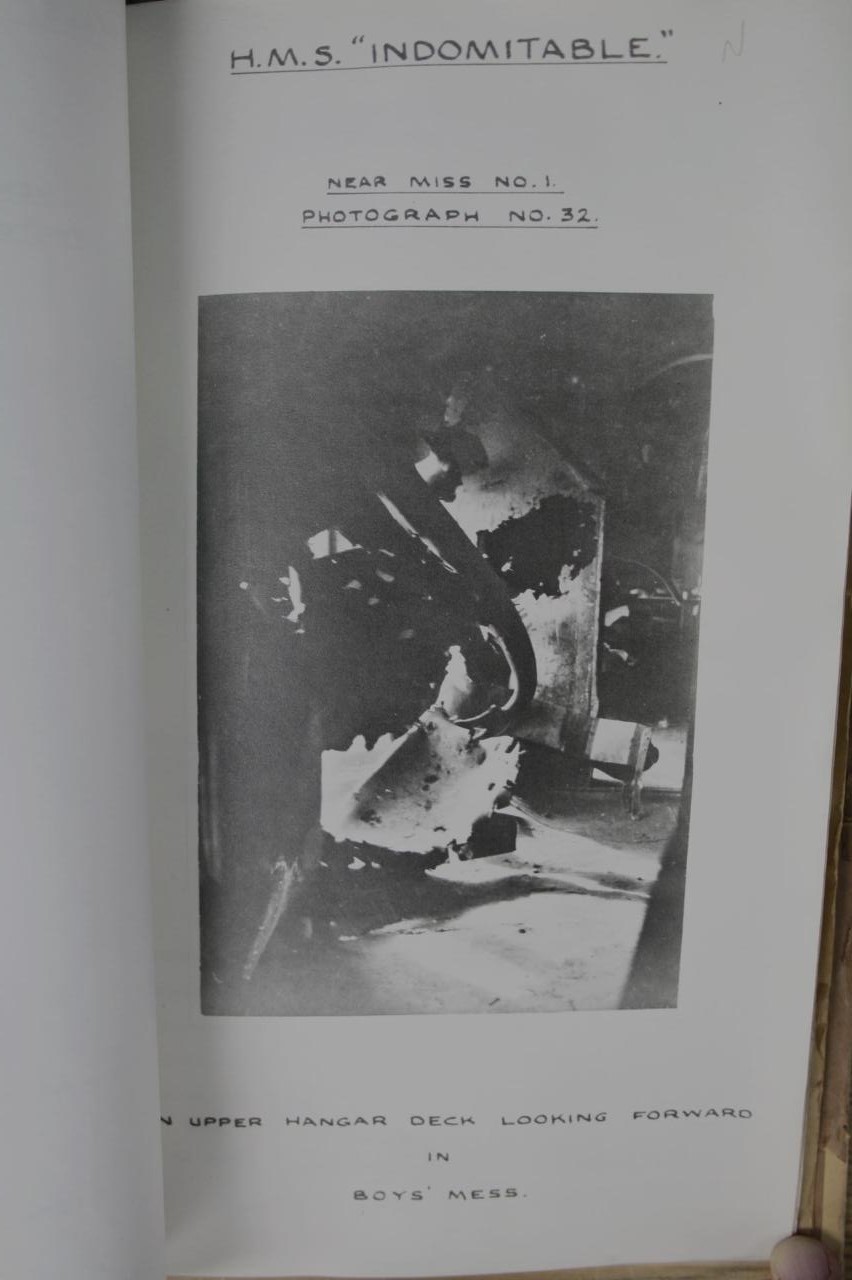
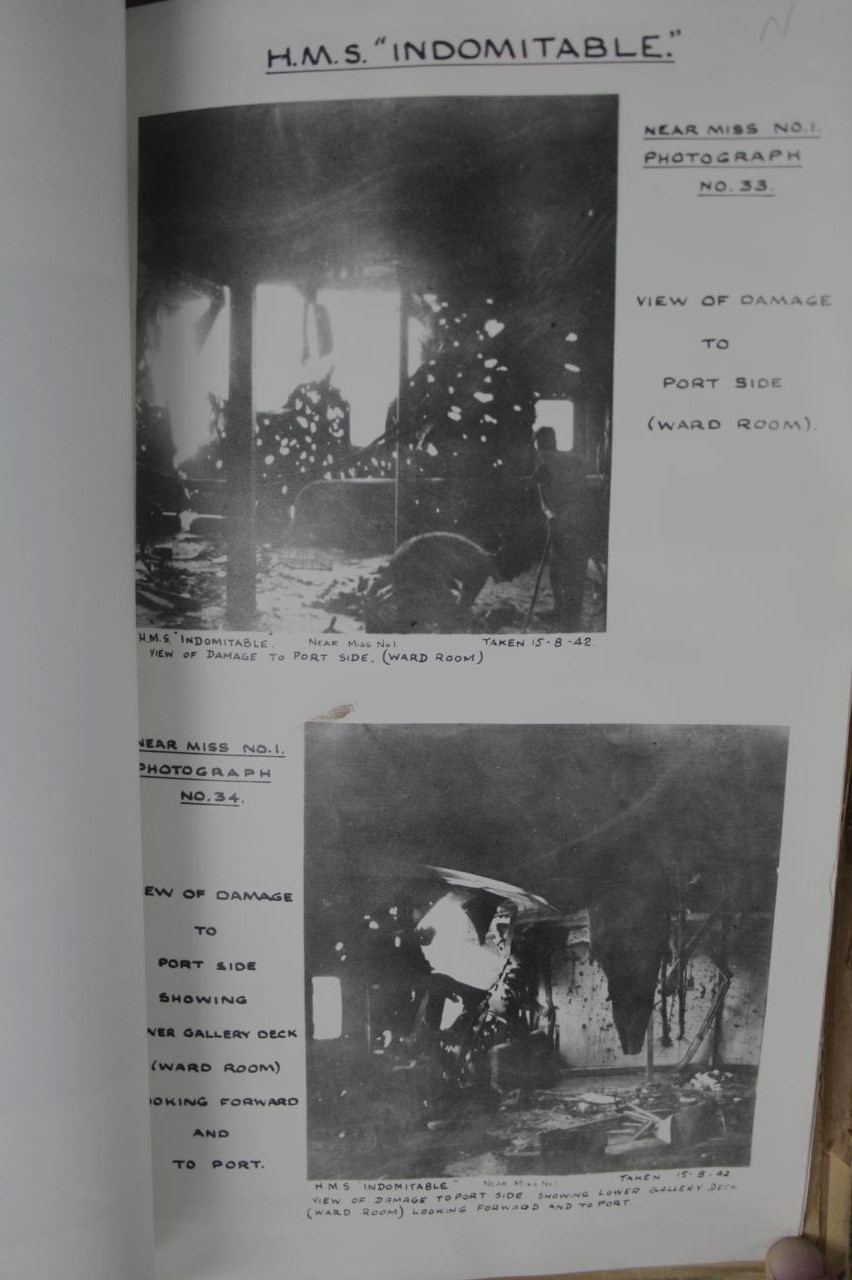


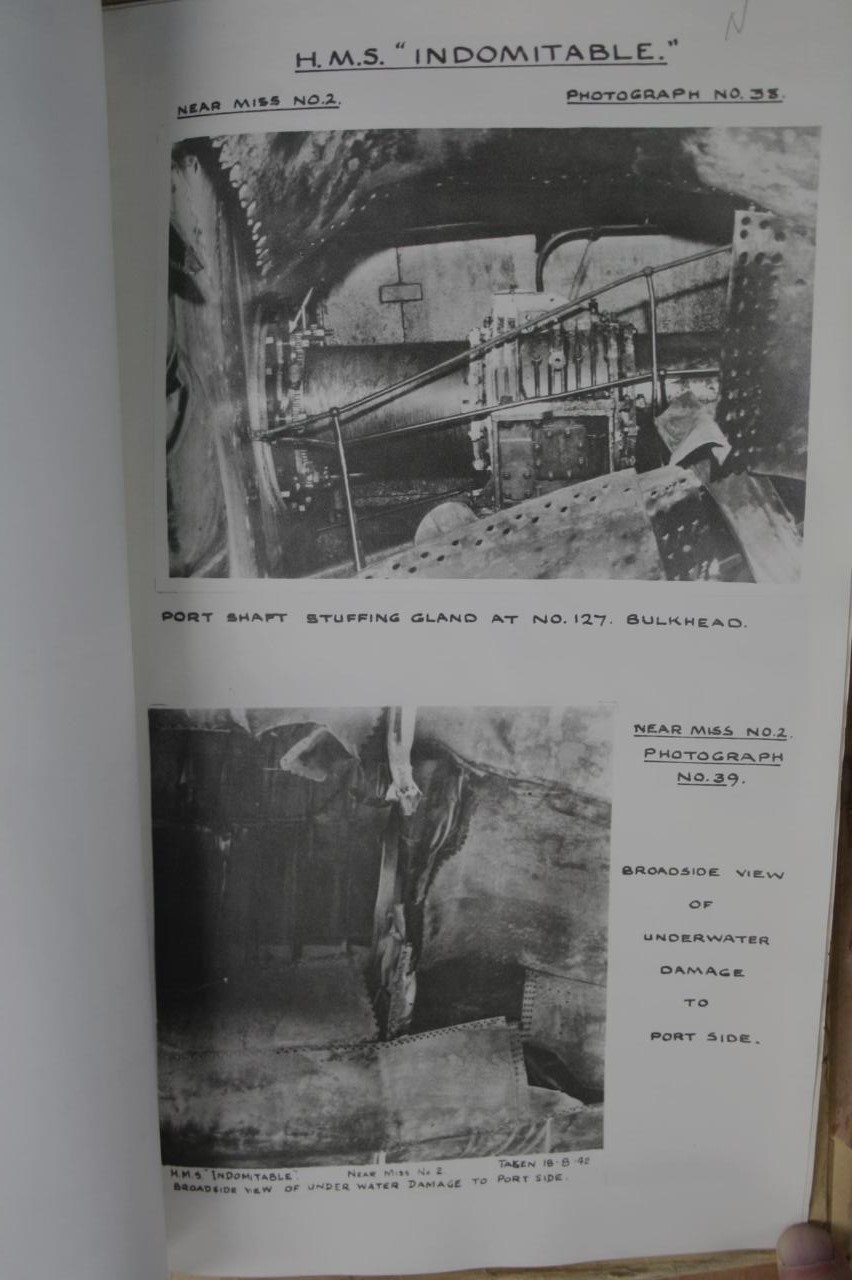

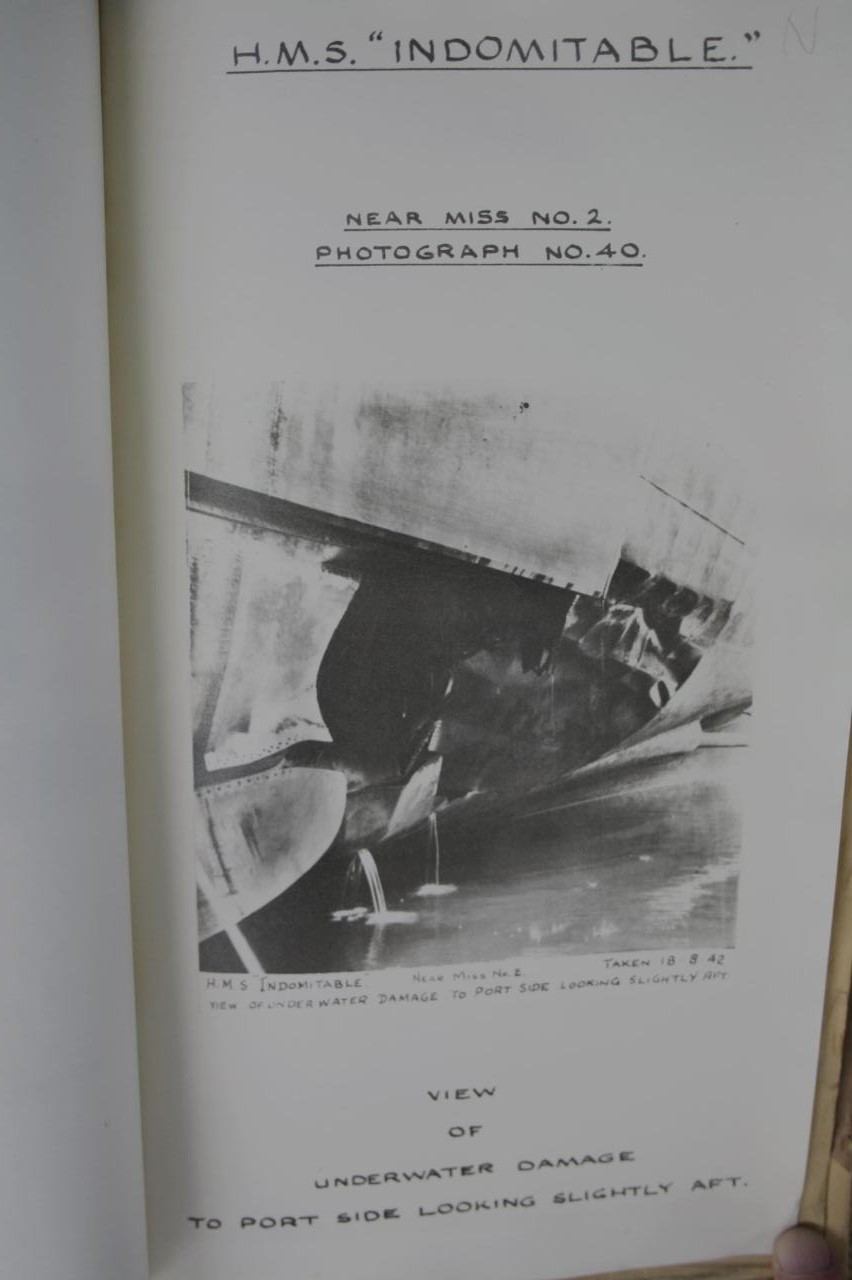
NID/0.6554/42 S E C R E T
DNC.4.B/R 123
8.12.42
H.M.S. INDOMITABLE
Copy No.9 of bomb damage sustained by
H.M.S. INDOMITABLE
on 12.8.42.
The report states that the bombs were 500 Kg. S.A.P., but there is no evidence to show how the size and nature were arrived at. Observations in flight would not provide this information and no bomb fragments were recovered.
The 14” hole in the 60lb. plate is insufficient for the passage of an S.D.500 Kg, as the diameter of the S.D. type now being used in 18” and that of the earlier type, which apparently the Germans have discarded for some considerable period, is 15.5. All recently recovered S.D. bombs of the 500 Kg. weight have been of the 18” diameter type and such bombs have been largely used in attacks on our coasts and shipping during the past 7 months.
The damage done by the bombs which struck inboard, is not inconsistent with the use of an S.C. type with 50% burster and corresponding to our M.C; the Germany type have just about sufficient strength to give the penetration reported. The considerable blast damage and the absence of damage by large fragments, tends to show that S.C. bombs were used.
In the case of the “Near Miss” 25ft. from the side of the ship, the damage was so extensive that D.U.B.D. would suggest that a bomb of greater weight than 500 Kg. was used, as the explosive effect of some 350 lbs. T.N.T. at 25ft. from the target (assuming that the charge has first burst open a 1” thick bomb casing) would hardly be sufficient to cause such extensive injury, and the damage is more consistent with the use of a larger bomb, such as the 1000 Kg. S.C.
The JU 87 B can carry 2-250 Kg and a 1000 Kg., while the JU 87 D can carry a 1400 Kg. with 2-250 Kg. or even an 1800 Kg. with 4 small 50 Kg. bombs. It has been reported that the JU 87 D. which is the latest type of dive bomber, is being largely used in the Mediterranean Zone.
The fuses used by the Germans would be either No.28 or No.38 Rheinmetall, with delay settings ranging between 0.06 and 0.08, in the case of the No.28 and 0.05 in the case of the No.38. The No.38 is the fuze generally used for ‘very’ low level attack, as it has a short arming time and a minimum delay of 0.05; a delay in the neighbourhood of 0.05 up to 0.08 is consistent with the distance of penetration after initial impact.
For maximum “Near Miss” effect the delay should not exceed 0.05, while any long delay used in conjunction with the thin walled bomb, would probably result in breaking up occurring before detonation.
D.U.B.D would therefore suggest that it is not safe to assume that the damage to the INDOMITABLE was caused by bombs of an S.A.P. type of 500 Kg. weight, but rather that the inboard damage was by 250 Kg. bombs and the “Near Miss” damage by a bomb of 1000 Kg. or larger.
(Signed)
D.U.B.D
1st January, 1943.
Mr. Offord (D.N.C)
Captain Llewellyn (D.U.B.D) phoned you today and I spoke to him in your absence. He wished to make some comments on D.N.C’s report on INDOMITABLE.
He pointed out (i) in paragraph IV (a) it is stated that the bombs were 500 k.g. S.A.P. type and (ii) in paragraph IV (b) that one such bomb made a hole 14” diameter; whereas the diameters of German bombs are as follows:-
500 k.g. S.D. – 18” diameter
250 k.g. S.D. – 14” diameter
And he thus considered that the bombs were 250 k.g. He said further, in collaboration, that is it known from captured German documents that the type of aircraft that made the attack can carry: -
2-250 k.g. bombs
1-large bomb (up to 1800k.g.).
He also made a statement that “the report shows that there was an absence of big splinter damage” and that the 250 k.g. bombs used were H.C. (high capacity – 50%) not S.A.P. (This does not appear correct. In the report splinters are recorded in each hit – some up to 52’ travel).
D.U.B.D. attempts to support this by arguing that the under water damage (by near miss No.2) over an area approx.. 40’ 20’, 25’ from the ship’s side could not be caused by the 320 lbs. T.N.T. in the 500 k.g. S.A.P. bomb, but is much more likely caused by 1,000 k.g. H.C. bomb.
(If we consider W= 320 lbs, (+) = 25 lbs in the formula D = 5W 4/9
t 1/3
we obtain D = 22.2’, so it is at once established that a 500 k.g. bomb (320 lbs T.N.T) could cause the damage involved. On the other hand, an S.A.P. type bomb would not give near miss under-water damage. This is much more likely to be caused by a H.C. or G.P type bomb).
Captain Llewellyn requested me to bring this to your notice.
L.N. Brook
Assistant Constructor
1-1-1943


